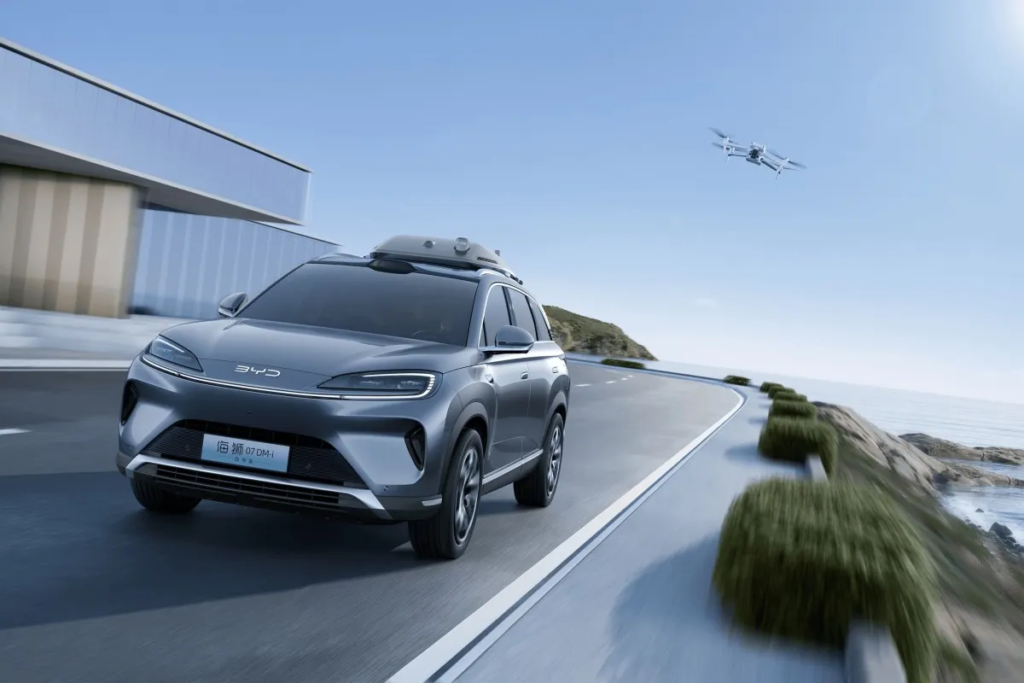
The automotive industry has witnessed rapid technological advancements in recent years, with electric vehicles (EVs), autonomous driving, and artificial intelligence reshaping the market. One of the most intriguing developments is the collaboration between BYD, China’s leading EV manufacturer, and DJI, the world’s foremost drone technology company. This partnership has led to the creation of an innovative drone-on-car system, known as Lingyuan, which seamlessly integrates a drone docking station into select BYD vehicles.
This pioneering system aims to revolutionize the driving experience by allowing users to capture aerial footage, navigate difficult terrains, and explore their surroundings—all from the comfort of their cars. This article delves into the technology, applications, advantages, market implications, and future prospects of the BYD-DJI drone integration.
The BYD-DJI Partnership: A New Era of Smart Mobility
Background of BYD and DJI
BYD (Build Your Dreams)
BYD is a globally recognized Chinese automotive and battery technology company. Founded in 1995, BYD has grown into a leader in electric vehicles (EVs) and energy solutions, often competing with global brands like Tesla. The company’s focus on sustainable transportation has helped it gain dominance in both the domestic and international EV markets.
DJI (Da-Jiang Innovations)
DJI, founded in 2006, is the world’s leading drone manufacturer, specializing in consumer, commercial, and industrial UAV (Unmanned Aerial Vehicle) technology. Its drones are widely used for photography, surveillance, mapping, and even logistics. DJI’s expertise in aerial imaging, stabilization, and AI-powered automation makes it the perfect partner for BYD’s latest innovation.
The collaboration between BYD and DJI marks a significant step toward the integration of aerial technology with automotive innovation.
The Lingyuan Drone-on-Car System: How It Works
The Lingyuan system is an advanced vehicle-integrated drone platform that enables seamless drone deployment, control, and retrieval. Here’s a breakdown of its key components:
The Drone
- 4K DJI Drone: The drone features a 4K UHD camera, enabling high-definition aerial footage and real-time streaming.
- Autonomous Navigation: It uses AI-assisted GPS tracking, object avoidance, and pre-programmed flight paths.
- Follow Mode: The drone can autonomously follow the car at speeds up to 54 km/h (34 mph).
- Return-to-Vehicle (RTV): Instead of the usual Return-to-Home (RTH) feature, the drone automatically returns to its docking station atop the car.
The Roof-Mounted Docking Station
- Compact Design: Occupies only 0.29 square meters (3.1 square feet) and stands 215 mm (8.5 inches) tall.
- Automated Takeoff and Landing: The system ensures precise and smooth drone retrieval.
- Weather Protection: A weatherproof enclosure shields the drone from harsh environmental conditions.
- Wireless Charging: The docking station supports high-speed charging, restoring 20% to 80% battery within 30 minutes.

Control & AI Integration
- Vehicle Infotainment System: The drone can be controlled via the vehicle’s touchscreen interface.
- Lingyuan App: Offers manual control, AI-assisted video editing, and automated flight modes.
- AI-Powered Object Recognition: The system can identify landmarks, obstacles, and moving objects, making it useful for professional and recreational applications.

Applications of the Drone-on-Car System
Adventure & Travel Photography
- Capture Breathtaking Aerial Shots: Travelers can record epic road trips and landscapes.
- Seamless Content Creation: Influencers and vloggers can livestream high-quality footage.
Surveillance & Security
- Remote Property Monitoring: Users can monitor homes, farms, or industrial sites from their cars.
- Emergency Assistance: In case of breakdowns or accidents, the drone can scout surrounding areas for help.
Off-Road Navigation & Exploration
- Scout Unexplored Terrain: Perfect for off-road enthusiasts and explorers navigating unknown areas.
- Wildlife Observation: Nature lovers can use drones to safely observe animals without disturbing them.

Industrial & Commercial Use
- Construction & Infrastructure Monitoring: Engineers can inspect sites without leaving their vehicles.
- Agriculture: Farmers can monitor crops, livestock, and irrigation systems in large-scale farms.
Emergency Services & Disaster Response
- Search & Rescue Operations: Drones can find missing persons in difficult-to-reach areas.
- Disaster Assessment: Emergency responders can quickly survey floods, earthquakes, or wildfires.
Market Impact and Competitor Analysis
Competitive Edge of BYD-DJI Collaboration
- First-of-Its-Kind Technology: No other automotive manufacturer has introduced an integrated drone solution like this.
- Enhanced Driving Experience: Sets BYD apart from competitors by adding cutting-edge aerial capabilities.
- Growing Demand for Smart Vehicles: The market for automated and connected cars is rapidly expanding.
Key Competitors
- Tesla: While Tesla focuses on autonomous driving and AI, it has not yet ventured into drone integration.
- NIO & XPeng: Other Chinese EV brands have focused on smart cabins and battery-swapping, but none have incorporated drone technology.
- Toyota & Volkswagen: These global automakers are investing in self-driving tech but lack aerial integration.
Challenges and Limitations
Technical Challenges
- Drone Reliability: Ensuring safe operation in various weather conditions.
- Charging Time: Reducing battery charging time for more frequent use.
Regulatory Issues
- Airspace Restrictions: Compliance with local drone laws and no-fly zones.
- Privacy Concerns: Addressing issues related to unauthorized surveillance and data protection.
Consumer Adoption
- Cost Factor: The system costs $2,200, which may limit adoption.
- User Learning Curve: Not all consumers may find drone piloting intuitive.
Future Prospects and Innovations
Expansion to More BYD Models
- Currently available in Yangwang U8, Sealion 07 DM-i, and Tang L SUV.
- Future models may include affordable and high-end variants.
Advanced AI & Automation
- Better Object Recognition: Improved AI for autonomous flight path optimization.
- Gesture & Voice Commands: Enhanced ease of use.
Global Expansion
- International Launch: Potential release in Europe, North America, and Southeast Asia.
- Partnerships with Other Automakers: DJI may license its technology to other brands.
Conclusion
The BYD-DJI collaboration represents a landmark achievement in the fusion of automotive and aerial technology. The Lingyuan drone-on-car system offers unparalleled advantages in photography, navigation, security, and emergency response. While there are challenges in regulation, pricing, and adoption, the technology holds immense potential for transforming the driving experience. As smart mobility advances, drone-integrated vehicles could become the next big trend in the automotive industry.
